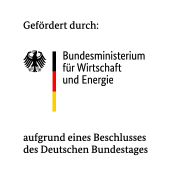Stability considerations for metallic strips under the influence of nozzle fields
In order to conserve resources, it is a consistent goal to reduce the material thicknesses of steel, aluminium and copper strip products in thin sheet applications. In the case of strip materials where the highest demands are placed on the surface and mechanical properties, continuous heat treatment is used to adjust the material properties. The aim of this project is to investigate the undesired belt vibrations during the gas cooling of the belts, to determine the influencing variables and to develop possible countermeasures.
The experimental and numerical investigations show that the flow of different slot nozzle systems for cooling the strip excites the strip broadband and the strip reacts to this by means of the first bending or first torsional vibration. From a vibration amplitude of > 20 mm, the strip vibrations are significantly amplified. This results from a fluid-structure interaction in which the flow forms a resonance body to the natural vibrations of the strip.
The strip vibrations are significantly reduced with increasing strip thickness due to a higher strip inertia and a higher absolute tension. On the other hand, the strip stability decreases disproportionately with the clamping length. The strip stability is antiproportional to the opening area of the nozzle systems, i.e. the smaller the slots, the greater the strip stability. By arranging the slots in such a way that pressure pads form as a function of the nozzle to the belt gap, the belt vibrations can be significantly reduced with the same nozzle opening area.
In an overall technical analysis including the heat transfer coefficient, it can be shown that in the investigated nozzle systems the free clamping length and the use of hydrogen / hydrogen-nitrogen mixtures are the largest actuators for improving strip stability. Should these possibilities be limited due to material restrictions (e.g. hydrogen embrittlement), an up to 30 % higher heat transfer with the same strip stability can be achieved by modifying the nozzle system.
Publications within the project
D. Büschgens: Numerische Untersuchungen zum mechanischen Bandverhalten in kontinuierlichen Wärmebehandlungsanlagen, Bachelorarbeit, RWTH Aachen, Institut für Industrieofenbau und Wärmetechnik, 07.2014
M. Strümpel: Simulation der Bandstabilität einer starren Platte im Schwebebandofen, Masterarbeit, RWTH Aachen, Institut für Industrieofenbau und Wärmetechnik, 12.2014
M. Crasmöller: Experimentelle Untersuchungen zum Bandschwingverhalten in Kühlstrecken von kontinuierlichen Wärmebehandlungsanlagen, Bachelorarbeit, RWTH Aachen, Institut für Industrieofenbau und Wärmetechnik, 08.2015

The IGF project 17988 N of the Forschungsvereinigung Forschungskuratorium Maschinenbau e.V. was funded by the AiF within the framework of the programme for the promotion of joint industrial research (IGF) of the Federal Ministry of Economics and Energy on the basis of a resolution of the German Bundestag.
Further information and the final report can be obtained from the Forschungskuratorium Maschinenbau e.V., Lyoner Straße 18, 60528 Frankfurt, Germany or info@fkm-net.de
